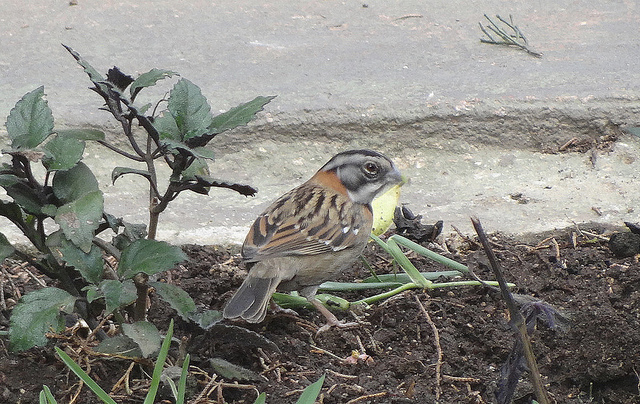
Original description: Fringilla Capensis Müller 1776
Taxonomic history in AOU/AOS Check-list
AOU 6 (1983): Rufous-collared Sparrow, Zonotrichia capensis
AOU 7 (1998): Rufous-collared Sparrow, Zonotrichia capensis
IUCN Conservation Status: Of least concern
Behavior:Over much of its range, the Rufous-collared Sparrow is common and tame in open habitats around farmsteads, in villages, and even on the lawns and sidewalks of large cities; it is equally at home along rustic fence lines and atop garbage cans in the Quito suburbs. Pairs or small flocks—perhaps family groups—feed quietly on the ground or low in brushy vegetation, rarely ascending much above human eye level in their search for seeds, fruits, invertebrates, and edible trash.
Rufous-collared Sparrows are tame but not entirely trusting, and if approached too quickly or too closely, fly a short distance into cover. The wing beats are fast and shallow, and the tail is generally held steady. Frightened birds usually re-emerge from their fastnesses after a minute or two, and can be watched at leisure by the quiet and careful observer.
Voice: The Colorado Rufous-collared Sparrow was first detected and identified by its song. In the early days of its long stay, the bird sang a slurred series of three notes similar in its melancholy tone and leisurely delivery to that of a Golden-crowned Sparrow; by late June, the sparrow was uttering at least four different song types, including one that regularly terminated in a slightly faster group of fuller descending notes or “slow trill.” This rather wide repertoire is typical of Rufous-collared Sparrows from sedentary tropical populations; elsewhere, among the resident populations to the north and the migratory populations to the south, individual birds appear to sing only one song type.
Across its vast “normal” range, the Rufous-collared Sparrow, similarly to the White-crowned Sparrow, exhibits wide variation in song, dialects associated not only with geographic distribution but with specific habitat types within a region.
“The song typically comprises 2-4 rising or falling whistled introductory notes… almost always followed by a terminal trill of more or less identical rapidly falling notes…. The most striking variation is in the rate of delivery of the elements of the terminal trill…. Diversity runs from buzz-like trills of ~5-millisecond intervals to languid whistled trills in which the trill elements are separated by 300-400 milliseconds. In some regions, birds produce more complex songs, with double trills, either fast-plus-slow or slow-plus fast….”
The frequently heard calls include a squeaky, explosive chink, and a “melancholy” descending tseeu
Detailed description and measurements drawn from standard reference works
Adult Zonotrichia capensis septentrionalis: Tail feathers dark rusty brown. Upper tail coverts and rump light unstreaked olive brown. Back and scapulars medium brown, the feathers with fairly broad black shaft streaks creating neat striping. Primaries dark buffy brown with narrow buffy edges; secondaries darker, with pronounced chestnut edges on outer web. Tertials blackish with broad chestnut edges on outer web. Greater coverts broadly blackish on outer, with broad brown to chestnut edges and large white tips. Median coverts blackish with large white tips. Marginal coverts of upper wing olive-gray, of under wing whitish. Nape bright unstreaked rust, sharply set off from back and from back of crown.
Under tail coverts dull white with concealed darker shaft streaks. Vent and center of belly dull white. Flanks and breast sides pale brownish, the color often extending slightly towards center of breast. Breast pale gray with variable brown streaking, gathering into central breast splotch on heavily marked birds. Throat bright white, bordered on the sides below by black wedge-shaped patches, which extend variably towards the center, sometimes nearly joining to form a narrow neat breast band. No lateral throat stripe, leaving throat and white jaw stripe continuous. Jaw stripe divided from dove-gray ear coverts by pronounced blackish whisker.
Crown with broad gray median stripe, broad black lateral crown stripes. Very wide gray supercilium, flaring towards nape. Forepart of supercilium tending towards grayish white. Sharp blackish eye line reaches from chestnut nape through eye to base of bill; lore slightly more diffusely black. Ear coverts gray, bounded black above and below and chestnut behind. Pale grayish eye ring interrupted by black eye line.
Tarsus and toes pinkish. Thick bill bluish gray above and below, slightly paler at base of both mandibles.
Juvenile Zonotrichia capensis septentrionalis: Tail feathers dark rusty brown. Upper tail coverts and rump light olive brown. Back and scapulars light buffy brown, the feathers with broad black shaft streaks creating broad, somewhat irregular striping. Primaries dark buffy brown with narrow buffy edges; secondaries darker, with pronounced chestnut edges on outer web. Tertials blackish with broad chestnut edges on outer web. Greater coverts broadly blackish on outer, with broad brown to chestnut edges and large white tips. Median coverts blackish with large white tips. Marginal coverts of upper wing olive-gray, of under wing whitish. Nape buffy or dull rust with narrow blackish streaks.
Under tail coverts buffy whitish with darker shaft streaks. Vent and center of belly buffy whitish with scattered streaks or spots. Flanks and breast buffy with conspicuous blackish wedge-shaped streaking. Throat dull buffy or whitish with scattered streaks and fairly clearly set off from buffier upper breast. No black patch at side of throat.
Crown dull brown with indistinct black-streaked buffy median stripe. Wide pale supercilium buffy brown with fine streaking. Brownish eye line reaches from nape through eye narrowly to base of bill; lore brownish. Ear coverts dull brownish buff. Faint freckled eye ring above and below eye, interrupted by eye line.
Tarsus and toes brownish or pinkish. Thick bill gray above and below, slightly paler at base.
Length 127-152 mm (5.0-6.0 inches)
Wing chord 61-72 mm (2.4-2.8 inches)
Tail 54-66 mm (2.1-2.6 inches)
W:T 1.14
Mass 26 g

